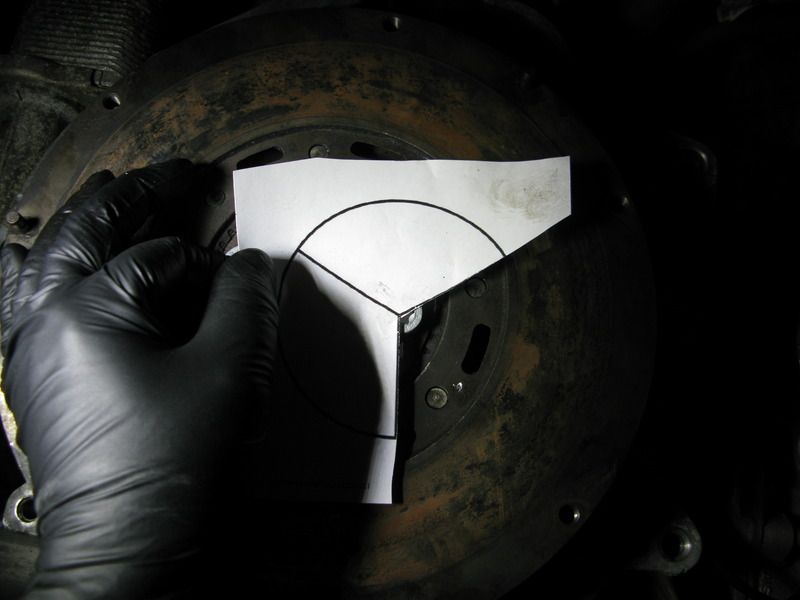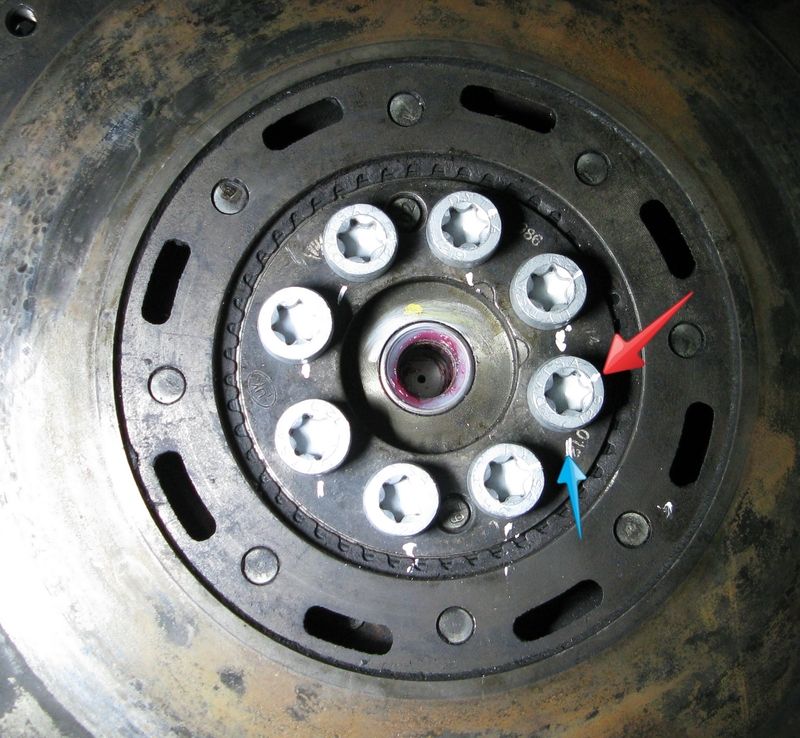 05-05-2017, 06:13 PM
05-05-2017, 06:13 PM
|
#1
|
|
Registered User
Join Date: Nov 2015
Location: Bracebridge, Ontario
Posts: 256
|
Flywheel Question
Evening Guys
I'm replacing the duel mass flywheel.
My questions is once the bolts are torqued to 19ftlb
How critical is it in getting the extra 120 degree
If your off a couple of degrees one way or another is it OK?
Please chime in.
Thanks Bart
__________________
My Beast 2004 Boxster SE #0174
- 3.8 with all the internal goodies, Under-mount Pulley, IPD Plenum, 996 Intake, Softronic Tune, 987 Factory Sport Exhaust, skid plates, IMS solution, Ohlins R&T, RSS Toe Links, Camber Plates, Michelin Pilot Super Sport on all 4 corners, Alpine Double Din c/w new speakers & amps.
|

|

|
 05-05-2017, 06:54 PM
05-05-2017, 06:54 PM
|
#2
|
|
Artist, 986S tinkerer
Join Date: Aug 2013
Location: Montreal, Canada
Posts: 1,821
|
I've never really understood this concept. When you install your under-drive pulley it says "torque to xx N-M, then turn + 90 degrees". Well, I didn't get out my protractor and my u-d pulley has yet to spin off into outer space! 
__________________
James now has: 2008 987S 6 speed
Crashed: 2010 987.2 pdk in speed yellow! 
Sold to a cool racer chick: 2004 986 S
YouTube channel: the PORSCHE as seen by NewArt
www.youtube.com/channel/UCohdrH2xHTklM1thxk0KKOQ?
|

|

|
 05-05-2017, 08:50 PM
05-05-2017, 08:50 PM
|
#3
|
|
Certified Boxster Addict
Join Date: Nov 2010
Location: Los Angeles
Posts: 7,669
|
A couple of degrees won't matter.
Here is a previous post explaning why it doesn't matter: http://986forum.com/forums/519900-post7.html
__________________
1999 996 C2 - sold - bought back - sold for more
1997 Spec Boxster BSR #254
1979 911 SC
POC Licensed DE/TT Instructor
Last edited by thstone; 05-05-2017 at 08:53 PM.
|

|

|
 05-06-2017, 07:29 AM
05-06-2017, 07:29 AM
|
#4
|
|
Registered User
Join Date: Feb 2005
Location: It's a kind of magic.....
Posts: 6,649
|
Quote:
Originally Posted by Muskoka Minute

Evening Guys
I'm replacing the duel mass flywheel.
My questions is once the bolts are torqued to 19ftlb
How critical is it in getting the extra 120 degree
If your off a couple of degrees one way or another is it OK?
Please chime in.
Thanks Bart
|
The object of the +120 degrees is to get a pre determined amount of bolt stretch. While some seem to feel it's accuracy is unimportant, I'm afraid that I cannot agree. Specs exist for a reason, in this case clamping force and bolt life; and with more and more OEM's using single use fasteners with "+angle" specs, measuring this is an everyday fact of life in the shop.
Two methods exsist for correctly measuring this unit; the first are the "torque angle" torque wrenches, which are capable of reading both in ft. Lbs. and then torque angle. This is what we use everyday. The second "poor man's" method is to put two small reference dots on each flywheel bolt hole with a sharpie; the first is a "zero" mark, the second is 120 degrees further in the bolt rotation. Install the flywheel, and torque each flywheel bolt to its spec. Now add another dot, this time aligning the "zero" reference dot on the flywheel with the new dot on the bolt. Once marked, you can now see when the bolt reaches the +120 reference mark on the flywheel. Simple, quick, and very accurate......
__________________
“Anything really new is invented only in one’s youth. Later, one becomes more experienced, more famous – and more stupid.” - Albert Einstein
|

|

|
 05-06-2017, 02:02 PM
05-06-2017, 02:02 PM
|
#5
|
|
Registered User
Join Date: Nov 2015
Location: Bracebridge, Ontario
Posts: 256
|
Thanks for the input guys....
She's going to go back together tomorrow.
Cheers!
__________________
My Beast 2004 Boxster SE #0174
- 3.8 with all the internal goodies, Under-mount Pulley, IPD Plenum, 996 Intake, Softronic Tune, 987 Factory Sport Exhaust, skid plates, IMS solution, Ohlins R&T, RSS Toe Links, Camber Plates, Michelin Pilot Super Sport on all 4 corners, Alpine Double Din c/w new speakers & amps.
|

|

|
 05-07-2017, 04:08 AM
05-07-2017, 04:08 AM
|
#6
|
|
Project Addicted
Join Date: Aug 2015
Location: Eastern Shore, MD
Posts: 623
|
Easy way to figure it:


I typed a long answer to the "why" and had a computer crash just before posting and got up and left in disgust. Stupid iMac....
SO I will try to make it shorter. The why is accuracy and very short bolts. the base torque value is used to stiffen the joint and make sure it's all metal to metal. Once the joint is metal to metal, all rotation goes into purely stretching the bolt. So, let's say we have a bolt the has 8 threads per inch, and once the joint is stiff, we turn it 1 revolution, the bolt must be 1/8 inch longer. This has been used for many years to tighten large bolts typically above 3" in diameter as torque wrenches didn't exist and some different thread forms could be used. The studs were gun drilled, a heater rod was placed inside and the bolt heated. Once it "grew in length" the nut could be turned by hand a certain amount, you pulled the heater rod out and as the bolt cooled the stud began to shrink and clamp load was induced.
This type of tightening allows the engineer to get the clamp load quite accurate because friction does not have to be considered in his load calculation. At final torque, friction can be eating up as much as 90% of the work done. the is the friction in the threads and under the nut or bolt head. In a joint like the flywheel, the scatter between bolts could be as much a +/- 25% from the spec just due to friction. The loads on a short bolt are very hard to get right and the "Angle of Turn" gets them to the accuracy level desired.
__________________
______
Jon
1966 912, 1976 911
1986 944, 2000 Boxster
|

|

|
 05-07-2017, 07:53 AM
05-07-2017, 07:53 AM
|
#7
|
|
Registered User
Join Date: Feb 2005
Location: It's a kind of magic.....
Posts: 6,649
|
One additional word of advice: Always use a proper lubricant, both on the threads and under the bolt heads when doing the flywheel. We prefer the ARP Ultra Torque product for this. Lack of lubrication actually makes the process both less accurate, and harder to accomplish.
__________________
“Anything really new is invented only in one’s youth. Later, one becomes more experienced, more famous – and more stupid.” - Albert Einstein
Last edited by JFP in PA; 05-07-2017 at 07:58 AM.
|

|

|
 05-07-2017, 11:57 AM
05-07-2017, 11:57 AM
|
#8
|
|
Beginner
Join Date: Mar 2013
Location: Houston
Posts: 1,659
|
I'm guessing Jon is an engineer (but not a computer engineer) because he is totally correct. Bolts can be considered (very stiff) springs that are stretched to hold parts together. Torquing a bolt is really a method to estimate bolt stretch. Because most of the turning force to tighten a bolt goes into overcoming friction between the threads, the actual bolt stretching part (pulling the spring tight) is a small percentage of the rotation force (torque) being applied. Worse yet, the friction force between the threads, particularly if they are dry (not lubricated), can vary wildly depending on the thread surface finish (and other factors) which may not be tightly controlled. So the majority of the torque is going into overcoming a friction force that may vary wildly bolt to bolt, and whatever is left over stretches the bolt. This is why bolt stretch is actually measured in high end engine connecting rods, and why it's important in high stress / strain applications like the flywheel to find a way to get all the bolts really close to the same tension (stretch) regardless of the torque required to get there to hold the parts together. A couple of degrees of rotation wont' be a big deal, but just torquing everything to the same high torque number might be.
__________________
2003 S manual
Last edited by Jamesp; 05-07-2017 at 12:02 PM.
|

|

|
 Posting Rules
Posting Rules
|
You may not post new threads
You may not post replies
You may not post attachments
You may not edit your posts
HTML code is On
|
|
|
All times are GMT -8. The time now is 10:57 AM.
| |